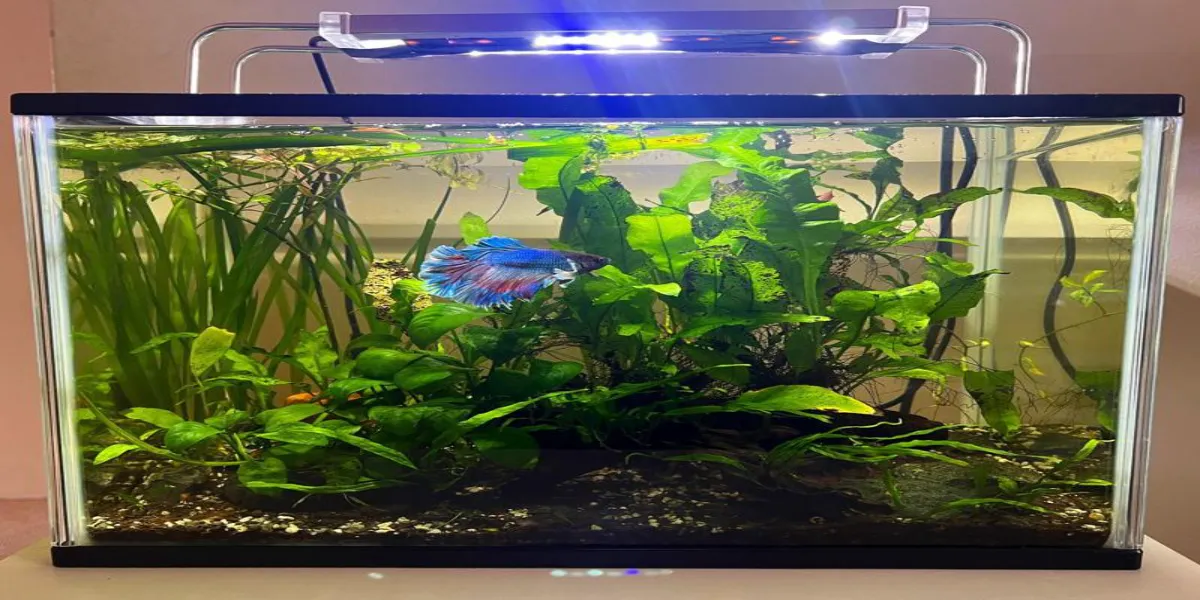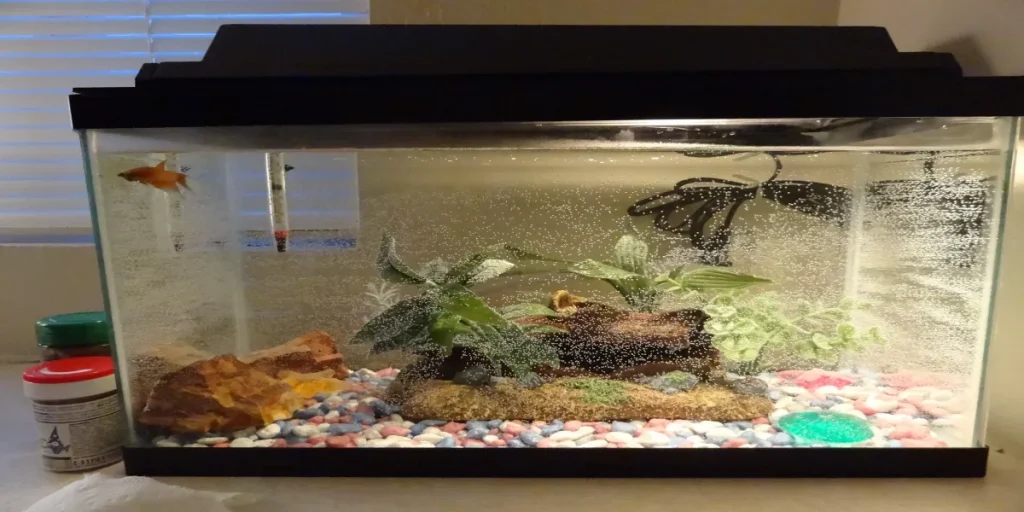Knowing what tank for a betta fish is crucial for its long-term health and happiness. Get it right, and you’ll have a vibrant, active pet; get it wrong, and you could face health issues or a lackluster fish.
This important decision affects not only your betta’s well-being but also how much you’ll enjoy keeping it as a pet.
This article will guide you through the process of determining the perfect tank size, exploring various types suitable for bettas, and tips on setting up your betta’s new home.
Dive in to ensure your betta fish thrives in its environment!

What Size Tank for a Betta?
For a betta fish, a tank that holds at least 5 gallons of water is recommended for optimal health and well-being. Larger tanks, like 10 gallons, are even better as they provide more space for swimming and easier maintenance. Smaller tanks are not advised due to stress and poor water quality.
Tank Sizes for Betta:
| Tank Size | Pros | Cons |
|---|---|---|
| 2-3 Gallons | Affordable, Easy to Place | Stressful for Betta, Frequent Cleaning Required |
| 5 Gallons | Minimum Recommended Size, Easier Maintenance | Takes Up More Space, Initial Cost Higher |
| 10 Gallons | Ideal for Swim Space, Can Add Tank Mates | Requires More Space, Higher Cost |
| 20 Gallons | Best for Multiple Fish, Easier to Maintain Water Quality | Takes Up Considerable Space, Highest Initial Cost |
Types of Tanks Suitable for a Betta
Glass Aquariums
Glass aquariums are a popular choice for betta fish. They’re strong and resist scratches.
The clear glass lets you see your betta fish easily. But remember, they can be heavy. So, choose a sturdy spot to place them.
Acrylic Tanks
Next, we have acrylic tanks. They’re lighter than glass, which makes them easier to move around. They’re also stronger than glass. But be careful! They can get scratched easily. So, handle with care!
Plastic Tanks
Plastic tanks are another option. They’re light and easy on the pocket. But there’s a downside. Over time, they can become cloudy. This makes it harder to see your betta fish.
Bowls
You might think about using a bowl for your betta fish. It’s true, they’re small and convenient. But here’s the thing: bowls are often too small for bettas.
They also lack space for important equipment like heaters and filters. So, bowls are not the best choice for your betta fish’s home.
The Importance of Tank Size for Betta Health

Stress Levels
Bettas, like humans, can experience stress. This stress can lead to a weakened immune system and make them more susceptible to disease.
A larger tank can significantly reduce these stress levels. In a spacious environment, bettas can comfortably explore and establish their territory, which is a natural behavior for them.
This sense of security and freedom can lead to happier, healthier fish.
Physical Space and Exercise
Just as we need room to move and exercise, so do bettas. In the wild, bettas have vast expanses of water to swim in.
In captivity, their movement shouldn’t be restricted. A larger tank allows bettas to swim freely and get the exercise they need.
Regular exercise helps bettas maintain a healthy weight and good overall health. It also provides mental stimulation as they navigate their environment.
Water Quality
Water quality is crucial for the health of any aquatic creature, and bettas are no exception. Larger tanks have a greater volume of water which can dilute toxins, such as ammonia and nitrites, more effectively than smaller tanks.
This results in more stable water parameters and a healthier living environment for your betta. Regular water changes and monitoring are still necessary but the fluctuations in water chemistry will be less drastic in larger tanks.
Social Interaction
While bettas are known for their aggressive behavior towards other bettas, they can coexist with certain other fish species in a large enough tank.
This social interaction can enrich the life of your betta, providing mental stimulation and mimicking the diversity they would encounter in the wild.
However, it’s important to research compatible species as not all fish make good tank mates for bettas.
What Else Should Be in the Betta Tank?
Filtration System
A filtration system is like a vacuum cleaner for your betta’s tank. It sucks up waste and harmful chemicals. This keeps the water clean and safe for your betta.
Heater
Bettas are tropical fish. They need warm water to stay healthy. A heater in the tank keeps the water at the right temperature. It’s like a cozy blanket for your betta!
Plants and Decorations
Plants and decorations are more than just pretty. They give your betta places to hide and play. It’s like having a fun jungle gym in their home!
Lighting
Lighting is important too. It helps plants in the tank grow. Plus, it shows off your betta’s beautiful colors. It’s like a spotlight on a stage!
Factors Affecting the Choice of Betta Tank Size

Betta Fish Size
Betta fish, also known as Siamese fighting fish, are relatively small. They typically grow to a length of 2.5 to 3 inches.
The size of the betta fish is a crucial factor when choosing a tank because it directly influences the amount of space they need to swim and thrive.
Tank Size
While betta fish are small, they are also active and need ample space to swim. The minimum recommended tank size for a betta fish is 2.5 gallons.
However, a larger tank of 5 gallons or more is preferable as it provides more room for swimming and exploration.
Tank Shape
The shape of the tank is another important consideration. Bettas are horizontal swimmers, meaning they prefer to swim side to side rather than up and down. Therefore, a long, shallow tank is more suitable than a tall, narrow one.
Water Quality
Bettas require clean water to stay healthy. A filter can help maintain water quality by removing waste and harmful chemicals.
It’s also recommended to change about 25% of the water every week to ensure freshness.
Temperature
As tropical fish, bettas thrive in warm water. The ideal temperature range for a betta tank is between 76-82°F (24-28°C).
A heater may be necessary to maintain this temperature range, especially in cooler climates.
Decorations
Decorations such as plants and caves not only enhance the aesthetics of the tank but also provide hiding spots for your betta.
However, ensure that these decorations are smooth and do not have sharp edges that could potentially injure your betta.
Tank Mates
While some bettas enjoy the company of other fish, others may prefer solitude.
It’s essential to understand your betta’s personality before introducing other fish into the tank. Some compatible species include neon tetras and ghost shrimp.
Common Mistakes to Avoid When Choosing a Tank Size
Overlooking Betta Fish Size
Betta fish, despite their small size, require ample space to swim and thrive.
Choosing a tank that’s too small can lead to stress and health issues for your betta. Always consider the size of your betta fish when selecting a tank.
Choosing the Wrong Tank Size
One common mistake is housing betta fish in a tiny bowl or a tank that’s too small. Betta fish require at least 2.5 gallons of water to swim freely.
A larger tank, ideally 5 gallons or more, is even better as it provides more room for swimming and reduces the frequency of water changes.
Ignoring Tank Shape
Betta fish are horizontal swimmers and prefer to swim side to side rather than up and down.
A common mistake is choosing a tall, narrow tank over a long, shallow one. The latter is more suitable for bettas as it provides more horizontal swimming space.
Neglecting Water Quality
Maintaining high water quality is crucial for the health of your betta fish.
Neglecting to use a filter or failing to change the water regularly can lead to poor water quality, which can harm your betta. It’s recommended to change about 25% of the water every week.
Not Controlling Temperature
Bettas are tropical fish and thrive in warm water temperatures between 76-82°F (24-28°C).
Not controlling the temperature or allowing the tank to get too cold can lead to health issues for your betta. Using a heater can help maintain the ideal temperature range.
Using Unsafe Decorations
Adding decorations like plants and caves can enhance the aesthetics of the tank and provide hiding spots for your betta.
However, using decorations with sharp or rough edges can injure your betta. Always choose smooth, safe decorations.
Not Considering Tank Mates
While some bettas enjoy the company of other fish, others prefer solitude. Adding other fish without considering your betta’s personality can lead to stress and aggression.
Always observe your betta’s behavior before introducing new tank mates.
FAQs
Can I use a bowl for my betta fish?
No, bowls are generally too small and lack space for essential equipment like heaters and filters.
Is a 2-3 gallon tank good enough for a betta fish?
No, a 2-3 gallon tank is not recommended due to stress and the frequent cleaning required.
Do betta fish need a heater?
Yes, bettas are tropical fish and require a heater to maintain water temperatures between 76-82°F (24-28°C).
Does a larger tank reduce stress for my betta fish?
Yes, larger tanks provide more space for swimming and exploration, which can reduce stress levels.
Are neon tetras good tank mates for bettas?
Yes, neon tetras are often compatible with bettas, but it’s essential to monitor behavior to ensure compatibility.
Conclusion
Choosing the right tank size is a vital part of keeping a healthy, happy betta fish. This article has guided you through the complexities of tank sizes, shapes, and materials, and has offered tips on creating an ideal habitat for your pet.
Armed with this knowledge, you are now prepared for responsible and enjoyable betta fishkeeping.

